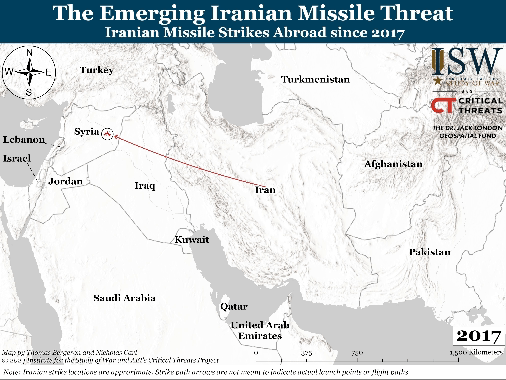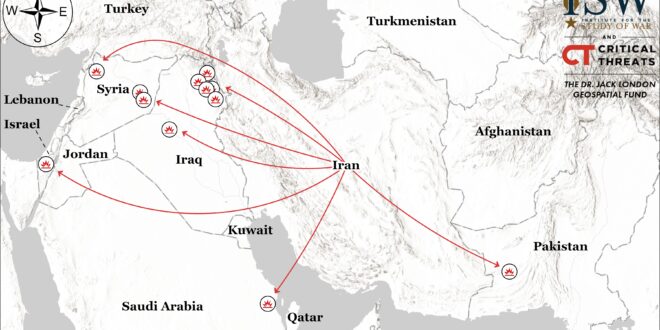The failure of Iran’s recent drone and missile attack on Israel is obscuring a critical inflection in the threat that Iran poses to the United States and its regional partners that has emerged over the past few years. Iran has shown that it is willing and able to project conventional military power from its own borders across the Middle East and that it is willing to risk escalation and even direct conflict to do so. That willingness marks a sharp change from Iran’s usual reliance on its Arab proxy and partner militias to project force. The so-called “Axis of Resistance” remains integral to Iranian force projection and regional strategy, to be sure. But Iranian leaders are also increasingly willing to use their own troops and weapons and to risk retaliatory attacks on Iran itself, as the April 13 attack on Israel demonstrated. That attack was not an isolated anomaly but rather part of a fundamental change in Iranian escalation calculus and regional strategy.[i] The United States and its partners must in turn change their approach toward escalation management and regional force posture to account for a world of direct Iranian conventional military threat even as they continue to face escalating attacks and threats from Iranian-backed proxy and partner militias.
The shift toward Iran using its own conventional military power began around 2015 when regular Iranian ground units went to Syria to fight on behalf of Bashar al Assad.[ii] Leadership cadres primarily from the Islamic Revolutionary Guards Corps (IRGC) embedded with other pro-Assad forces and worked with them to plan and conduct protracted campaigns against the Islamic State in Iraq and Syria (ISIS) and the Syrian opposition.[iii] These cadres helped coordinate and organize pro-Assad forces while providing them some armor and artillery support. They even sustained relatively high casualties in some instances.[iv] The deployments of command cadres from regular Iranian ground forces units to fight abroad for the first time since the Iran-Iraq War in the 1980s proved vital to the Iranian effort to keep the Assad regime in power. They also demonstrated a new readiness in Tehran to use Iranian conventional power rather than simply fighting through proxies and partners.
The willingness in Tehran to use Iranian conventional military force abroad expanded further in 2017, even as the most intense fighting of the Syrian civil war drew down. The IRGC launched several ballistic missiles from Iran at ISIS positions in eastern Syria that June—the first time that Iran had fired missiles abroad since 2001.[v] The IRGC has conducted another 11 attacks from Iran against targets around the Middle East since its 2017 strike into Syria. These attacks including the following in addition to the April 13 strike on Israel:
- The IRGC conducted a drone and missile attack targeting the Abqaiq crude-processing plant in Saudi Arabia in September 2019.[vi] The attack temporarily cut Saudi oil output by about half. The attack was part of a larger Iranian campaign targeting oil assets and infrastructure in response to US sanctions. The strike on Abqaiq marked the first time that Iran conducted such an attack into Saudi Arabia.[vii]
- The IRGC conducted a missile attack targeting US positions in Iraq, including the Ain al Asad airbase, in January 2020.[viii] Tehran was responding to the United States killing Qassem Soleimani and his top Iraqi lieutenant, Abu Mehdi al Muhandis, in a drone strike at the Baghdad International Airport several days beforehand. The attack on US forces marked the first time that Iran had conducted a direct strike on US service members from Iranian territory.
- The IRGC conducted three separate missile attacks into Iraq, Syria, and Pakistan on January 15 and 16, 2024.[ix] Iran claimed that it targeted alleged Israeli intelligence centers in Iraq, ISIS positions in Syria, and Baloch separatists in Pakistan. Iran had already conducted several previous missile strikes into Iraq and Syria at this point, but the strike into Pakistan was the first of its kind and caused a brief flare-up in tensions between Islamabad and Tehran.

These attacks show that Iranian leaders have become bolder in using their conventional military power. They have continued to conduct unprecedented attacks into neighboring states and accepted the risk that such strikes could trigger retaliatory strikes on Iran itself and prompt a larger regional escalation. Iran’s attacks abroad also show how it is using its conventional capabilities to complement rather than replace the rest of its Axis of Resistance. Iranian leaders still rely heavily on their Arab proxies and partners to project force. Tehran views its own conventional power as a force multiplier and step up the escalation ladder.
Iran will almost certainly continue to project its own conventional military power while continuing to support its Arab proxies and partners until it is deterred from doing so. Iranian leaders will also continue to use this military strategy in support of their efforts to attain regional hegemony, destroy the Israeli state, and expel American influence from the Middle East. The United States must recalibrate its own regional strategy and posture in light of this new reality.
US efforts to build a regional air defense network with partner states take on much greater urgency in this changing strategic context. This air defense cooperation was crucial in intercepting the vast majority of the projectiles that Iran fired at Israel on April 13.[x] The proactive efforts by the United States to cultivate political and military coordination between Israel and the Arab states in recent years made the high rate of interceptions possible. Iranian leaders will undoubtedly learn from that event, however, and examine how to make their drone-missile strike packages more effective and better at defeating the air defenses that they faced. The United States and its partners must similarly learn from that event—and the broader shift in how Iran uses force—and accordingly double down on building a defensive architecture across the Middle East with the aim of deterring future Iranian aggression and experimentation along these lines.
 Eurasia Press & News
Eurasia Press & News




